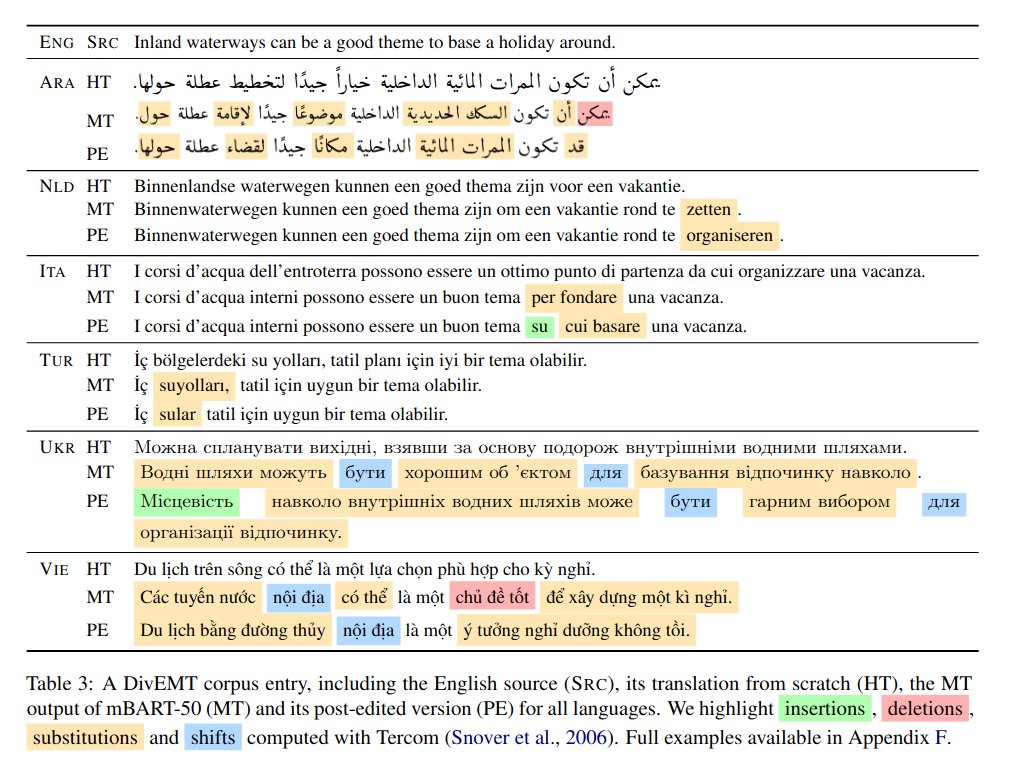Gabriele Sarti • Arianna Bisazza • Ana Guerberof Arenas • Antonio Toral
Abstract: We introduce DivEMT, the first publicly available post-editing study of Neural Machine Translation (NMT) over a typologically diverse set of target languages. Using a strictly controlled setup, 18 professional translators were instructed to translate or post-edit the same set of English documents into Arabic, Dutch, Italian, Turkish, Ukrainian, and Vietnamese. During the process, their edits, keystrokes, editing times and pauses were recorded, enabling an in-depth, cross-lingual evaluation of NMT quality and post-editing effectiveness. Using this new dataset, we assess the impact of two state-of-the-art NMT systems, Google Translate and the multilingual mBART-50 model, on translation productivity. We find that post-editing is consistently faster than translation from scratch. However, the magnitude of productivity gains varies widely across systems and languages, highlighting major disparities in post-editing effectiveness for languages at different degrees of typological relatedness to English, even when controlling for system architecture and training data size. We publicly release the complete dataset including all collected behavioral data, to foster new research on the translation capabilities of NMT systems for typologically diverse languages.
This repository contains data, scripts and notebooks associated to the paper "DivEMT: Neural Machine Translation Post-Editing Effort Across Typologically Diverse Languages". If you use any of the following contents for your work, we kindly ask you to cite our paper:
@inproceedings{sarti-etal-2022-divemt,
title = "{D}iv{EMT}: Neural Machine Translation Post-Editing Effort Across Typologically Diverse Languages",
author = "Sarti, Gabriele and Bisazza, Arianna and Guerberof Arenas, Ana and Toral, Antonio",
booktitle = "Proceedings of the 2022 Conference on Empirical Methods in Natural Language Processing",
month = dec,
year = "2022",
address = "Abu Dhabi, United Arab Emirates",
publisher = "Association for Computational Linguistics",
url = "https://aclanthology.org/2022.emnlp-main.532",
pages = "7795--7816",
}The DivEMT Explorer is a Streamlit demo hosted on allowing for a seamless exploration of the different examples that compose the DivEMT dataset, across modalities and languages. Have a look!
The processed DivEMT dataset is accessible as a 🤗 Dataset via the GroNLP organization, or alternatively as a two TSV files (one for the main task and one for the warmup) in the data folder. The raw .per files produced by PET are also released in the folder data/raw to foster more fine-grained exploration of the translation process. Questionnaires questions and responses can be found in the data/questionnaires folder.
The procedure requires Python > 3.8 and a Java installation to run Tercom.
- Clone this repository and install it as a Python package:
git clone https://github.com/gsarti/divemt
cd divemt
pip install -e .- Run the setup script to unzip all raw data folders.
chmod +x scripts/setup.sh
./scripts/setup.sh- Run the preprocessing script to produce the TSV files containing sentences, scores and metrics. Run time is ~2 minutes with only raw metrics, +30 min for annotations and +45 min for QE tags, assuming GPU availability for SimAlign.
# Run the preprocessing script
# --output_texts: Output TSV files with sentences (only scores otherwise)
# --add_edits: Add HTER, CharacTER and edit types breakdown to scores
# --add_evals: Add Bleu and ChrF to scores
# --add_extra: Add extra derived metrics to scores
# --add_annotations: Add Stanza annotations to sentences
# --add_wmt22_quality_tags: Add WMT22 quality tags to source and mt sentences for PE settings
# --output_single: Produces individual TSVs for every language-translator pair in the respective language folders
# --output_merged_subjects: Produces TSVs grouping all translators for every given language
# --output_merged_languages: Produces the final TSV with all languages and translators
python scripts/preprocess.py \
--output_texts \
--add_edits \
--add_evals \
--add_extra \
--add_annotations \
--add_wmt22_quality_tags \
--output_single \
--output_merged_subjects \
--output_merged_languages- The final data are produced as follows:
import pandas as pd
main = pd.read_csv('data/processed/merged/full_main.tsv', sep="\t")
main_texts = pd.read_csv('data/processed/merged/full_main_texts.tsv', sep="\t")
warmup = pd.read_csv('data/processed/merged/full_warmup.tsv', sep="\t")
warmup_texts = pd.read_csv('data/processed/merged/full_warmup_texts.tsv', sep="\t")
main_texts.drop("lang_id", axis=1, inplace=True)
warmup_texts.drop("lang_id", axis=1, inplace=True)
df_main = pd.concat([main, main_texts.iloc[:, 1:]], axis=1)
df_warmup = pd.concat([warmup, warmup_texts.iloc[:, 1:]], axis=1)
df_main.to_csv("data/main.tsv", sep="\t", index=False)
df_warmup.to_csv("data/warmup.tsv", sep="\t", index=False)These final files correspond to the two TSV files found in the processed version of DivEMT on 🤗 Datasets and for the DivEMT Explorer.
Follow along the analysis notebook after running the preprocessing script to produce plots and tables.
Follow along the modeling notebook (or open its knitted HTML report in the browser) to inspect the results from the modeling analysis.
For any problem or question regarding DivEMT, please raise an issue in this repository.

